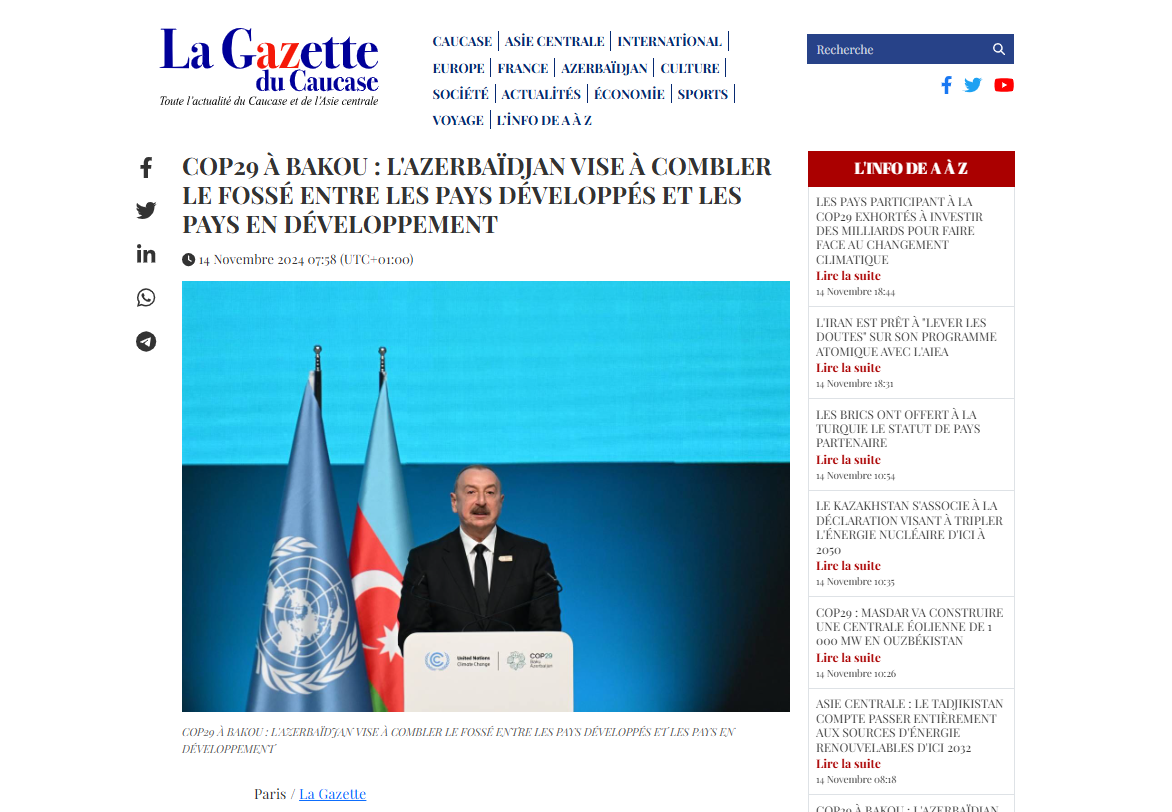BAKU, Azerbaijan, November 15. COP29 aims to address critical global climate challenges, focusing on climate finance, mitigation, and adaptation, an article by the French online outlet La Gazette du Caucase reads, Trend reports.
Quoting President Ilham Aliyev as he addressed the COP29 World Leaders Climate Action Summit, La Gazette writes: "Azerbaijan will strive to find common ground between developed and developing nations, as well as between the global South and North. President Ilham Aliyev highlighted Azerbaijan’s effective leadership in the Non-Aligned Movement over the past four years - the second-largest international organization after the United Nations - as evidence of the country’s extensive experience in leading global initiatives."
"On November 11, the COP29 global climate conference began in Baku, Azerbaijan. The country was unanimously confirmed as the host during the COP28 plenary session on December 11, 2023, with the collective support of the global community.
President Ilham Aliyev pointed out that Azerbaijan remains committed to facilitating climate action and that the country’s green agenda aims to unlock the vast technical potential of renewable energy, estimated at 135 GW on land and 157 GW offshore. The country has made significant strides to harness this potential, including investments in a 230-MW solar power plant by Masdar of the United Arab Emirates, the largest in the region. Additionally, Saudi Arabia’s ACWA Power is constructing a wind power plant with a potential capacity of 240 MW.
"During COP29, an agreement will be signed with bp from the UK to build a 240-MW solar power station in the district of Jabrayil, which was liberated from Armenian occupation four years ago. This project will provide decarbonization of one of the biggest oil and gas terminals in the world, the Sangachal terminal," the President of Azerbaijan announced, noting that Azerbaijan plans to construct around 6 GW of solar, wind, and hydroelectric power plants by 2030. Overall, the country has signed contracts and memorandums of understanding for 10 GW of renewable energy projects. The country’s green agenda also covers various internal regions, including Nakhchivan, Karabakh, and the East Zangazur regions, which have been declared green energy zones.
A total of 10,000 MW of alternative energy potential has been identified in the Karabakh (Garabagh) and East Zangazur regions since their liberation in 2020. These regions possess nearly all types of renewable resources, including hydro, solar, wind, and geothermal energy. After the Nakhchivan Autonomous Republic, the districts of Fuzuli, Jabrayil, and Zangilan rank second in solar potential, with solar radiation per square meter in these areas estimated between 1600 and 1700 kWh per year and a total solar capacity estimated at 7,200 MW. The wind potential is particularly high in the Kalbajar and Lachin districts, where the average annual wind speed reaches 10 meters per second, with a capacity estimated at 2,000 MW in the mountainous areas of the Karabakh region. Additionally, the districts of Kalbajar, Lachin, and Shusha have significant thermal water resources, with daily production reaching 4,000 to 5,000 cubic meters.
The economic potential of green energy sources in Azerbaijan amounts to 27 GW, comprising three gigawatts of wind energy, 23 GW of solar energy, 380 MW of bioenergy potential, and 520 megawatts of potential from mountain rivers, according to the Ministry of Energy.
Azerbaijan ratified the United Nations Framework Convention on Climate Change (UNFCCC) in 1995. The country joined the first global climate change protocol of the Convention, the Kyoto Protocol of 1997, in 2000. The Kyoto Protocol limits greenhouse gas emissions, which cause global warming. Azerbaijan later confirmed its commitments under the 2015 Paris Agreement to reduce greenhouse gas emissions by 35% by 2030 and by 40% by 2050," the article reads.







